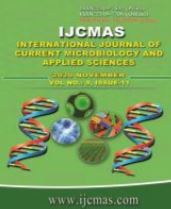


 National Academy of Agricultural Sciences (NAAS)
National Academy of Agricultural Sciences (NAAS)

|
PRINT ISSN : 2319-7692
Online ISSN : 2319-7706 Issues : 12 per year Publisher : Excellent Publishers Email : editorijcmas@gmail.com / submit@ijcmas.com Editor-in-chief: Dr.M.Prakash Index Copernicus ICV 2018: 95.39 NAAS RATING 2020: 5.38 |
A study was conducted on qualitative and quantitative analysis of phytoplankton to identify and estimate the abundance of phytoplankton in the Muddy pond, Stone pitched pond and Beni River. Analysis of phytoplankton samples recorded a total of 5 classes of phytoplankton viz.; Bacillariophyceae, Chlorophyceae, Cyanophyceae, Euglenophyceae and Fragilariophyceae. Out of 15 phytoplankton genera identified, 1 belong to Cyanophyceae, 5 to Chlorophyceae, 7 to Bacillariophyceae, 1 to Euglenophyceae and 1 to Euglenophyceae. Among the identified genera, Gomphonema, Caloneis and Naviculawere found to be dominant genera. Total phytoplankton abundance was varied from 37632 cells/l to 40436 cells/l in the experimental ponds. Among all experimental ponds, Bascillariophyceae was found dominant. Second dominant group was Euglenophyceae observed in Stone pitched pond. Total phytoplankton densities were recorded 40436 cells/l, 34840 cells/l and 37620 cells/l in Muddy pond, Stone pitched pond and Beni River respectively. Management technique and water quality parameters were also studied during study period namely water temperature, Total dissolved solids (TDS), dissolve oxygen and pH. The present study reveals that phytoplankton species are variable among the different water bodies and their density is also variable. There is a certain decline in plankton density during monsoon which gradually increases post monsoon. The information provides for more research to match water quality and pond phytoplankton characteristics in earthen aquaculture systems with and without fish stocking.
 |
 |
 |
 |
 |